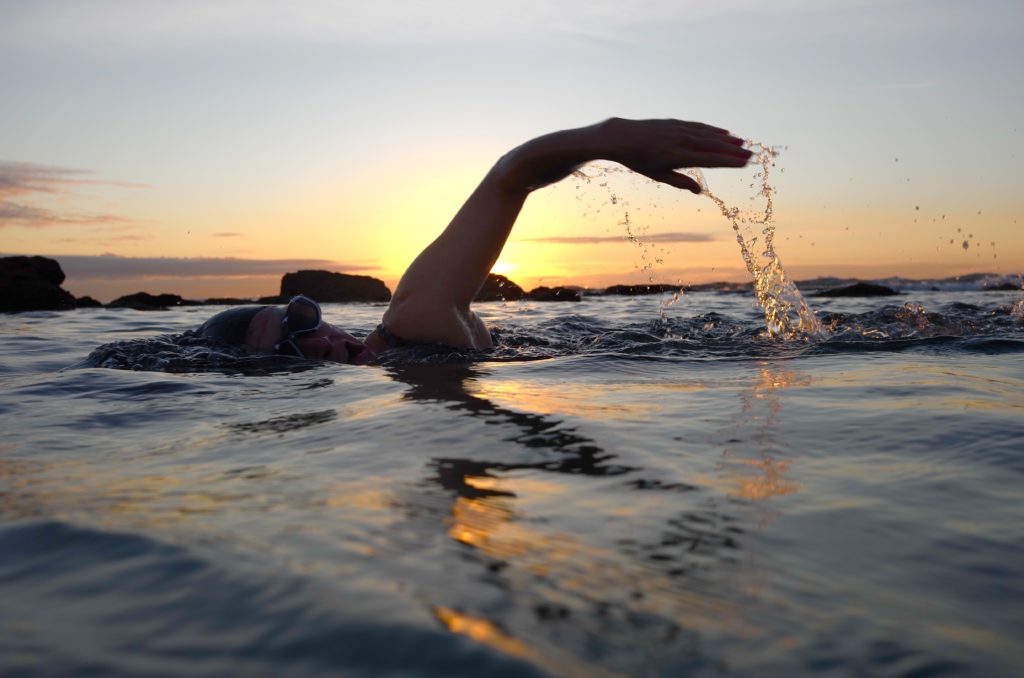Should I Learn…….For Swimming

Training for the swim in triathlon can be confusing. When we think of swimming, we tend to defer to pool competitive swimming or swim lessons. In triathlon the skills and strategy needed for a strong swim leg aren’t the same. After having gotten tons of questions in my Instagram DMs and in real life on “should I learn this?” in swimming, I’ve decided to put together a definitive guide for new swimmers.
Note that when I say “NO” to a skill, this means it’s irrelevant for triathlon training- if you want to learn or improve that skill, go for it! I am not the sole authority on this but this is the advice I give if I’m asked.
Should I Learn How To Breathe On My Side? YES
If you’re looking for one skill to build for your first triathlon, this is it. Breathing to the side helps maintain a buoyant body position. This will make your stroke more efficient, and overall leads to stronger swimming. Whether this is learning to breathe to the side as opposed to bringing your head forward or you’re moving from one-sided breathing to bilateral breathing, I highly recommend mastering this before a triathlon or open water swim racing. Don’t be too hard on yourself if it doesn’t come quickly or naturally to you- this is one of the toughest skills to learn if you haven’t been swimming for a while, and I’ve seen this as a challenge from swimmers of all ages.
Should I Learn How To Tread Water? YES
Treading water is vital not only for strong swimming, but safe swimming. Whether you’re getting tired, waiting for a friend, or relaxing, treading is what you’ll need to master. I am a huge proponent of safety as the first priority in open water swimming, and treading is a skill you can pick up in the pool or in open water that benefits both. Treading can also help you warm up when training in colder water, further cementing it as a top water safety skill. That said, treading isn’t the only swim skill that comes in handy for safety, continue reading.
Should I Learn To Float On My Back? YES
Floating on your back is a great way to take a quick rest, whether in training or a race. During my first triathlon, I dealt with cold shock, or a shock to my system due to the cold temperature of the water. To help manage this, I did some backstroke and back floating. This kept my face out of the water and kept myself and other swimmers safe. Floating on your back will help you build a stronger relationship with how your body moves in the water. Correct body positioning is one of the best ways to gain speed and efficiency in the swim. It will also stay calm and safe during moments of panic.
Should I Learn How To Do A Flip Turn? NO, BUT:
This one has a bit of nuance that I went into in this article, but if you ask me for a hard yes or no, I’m always going to say no. I see a lot of triathletes get hung up on flip turns. This is not a skill you’re going to use in an open water race. However, if you are training for a pool triathlon, flip turns may help your swim leg be more efficient. By using flip turns instead of touch turns, you will gain more momentum off the wall, but this is only relevant in the pool. If you find yourself swimming one length of the pool and stopping, flip turns can help you to do more laps. If you are trying to build skills off a very basic swim base, skip the flip turns.
Should I Learn The Other Strokes? YES, BUT:
For triathlon, breaststroke and butterfly are not strokes you must know. You can get through any triathlon with just freestyle, but knowing breaststroke is helpful. The water may be colder or more murkier than expected. This will give you the ability to have your face forward when breathing and sighting. In fact, my friend Laura does breaststroke for the entire swim leg! Backstroke is also helpful as for recovery and safety, it is not needed for a successful triathlon.
Should I Learn To Hold My Breath Longer Underwater? NO
Maybe I’m biased because my first concussion was due to a freak accident during an underwater set. I don’t recommend breath drills and breath-holding exercises in general. For beginner triathletes, taking less breaths during a swim is not going to affect your overall time to make it a main focus. Breath-holding without supervision or knowledge can be dangerous, whether it’s trying to swim a length of freestyle without breathing or going underwater for a long period of time. You will become more efficient with practice (example: breathing every 5 strokes instead of 3) but taking a breath is encouraged in the swim leg of a triathlon. If you’re entering Masters swimming, though, you may want to start figuring out breath efficiency, especially for sprint events like the 50 or 100 free. For your first triathlon, don’t focus on holding your breath underwater.

Danielle Moore is a swimmer and triathlete living outside Philadelphia, Pennsylvania. Her athletic journey picked up at 10 years old when she started swimming in the summers, and ended up as a butterflyer for both her high school and college teams. She ran track in middle and high school as well, but swimming is her true passion in sports. Danielle has also been teaching swim lessons since 2010 and received her US Masters Swimming Level 1 Coach certification in March 2022. She raced her first sprint triathlon in 2019 and has been hooked ever since- she will be racing her first half Ironman in September 2022.









